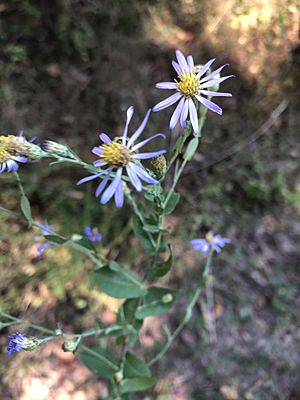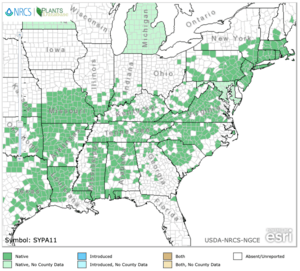Late purple aster facts for kids
Quick facts for kids Late purple aster |
|
|---|---|
 |
|
| In Davidson County, North Carolina | |
| Scientific classification | |
| Genus: |
Symphyotrichum
|
| Species: |
patens
|
 |
|
| County-level distribution map of Symphyotrichum patens | |
Symphyotrichum patens, often called the late purple aster or spreading aster, is a beautiful wild flower. It grows year after year, mostly in the eastern United States.
What Does It Look Like?
The late purple aster is a small plant, usually growing up to about 1 meter (3 feet) tall. It spreads out as it grows. Its leaves are shaped like eggs or long ovals. They wrap around its slightly fuzzy stem.
The flowers are not very big, less than 3 cm (1.2 in) across. They have pretty light blue or violet petals. The center of each flower is bright yellow. You can see these flowers blooming from August to October.
Its Plant Family
The Symphyotrichum group of plants has about 90 different kinds. Many of them look very much alike! This can make them tricky to tell apart.
This plant was first officially named Aster patens in 1789. Later, in 1995, a scientist named Guy L. Nesom moved it to the Symphyotrichum group. It is closely related to other asters like Symphyotrichum georgianum and Symphyotrichum phlogifolium.
Scientists have also found a few different types, or varieties, of this plant:
- Symphyotrichum patens var. patens
- Symphyotrichum patens var. gracile (Hook.) G.L.Nesom
- Symphyotrichum patens var. patentissimum (Lindl.) G.L.Nesom
- Symphyotrichum patens var. terranigrum J.J.N. Campbell & W.R.Seymour
Where Does It Grow?
The late purple aster grows in many places. You can find it from southern Maine all the way south and west to East Texas.
This plant likes sunny spots or places that get a lot of sun. It often grows in open woodlands. Not much is known about its daily life or how it interacts with other plants and animals. Most of what we know comes from lists of plants found in different areas.
Images for kids






